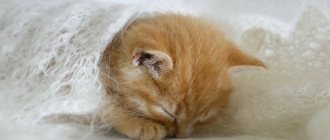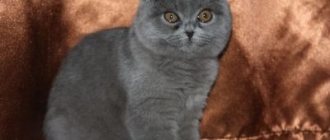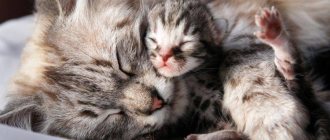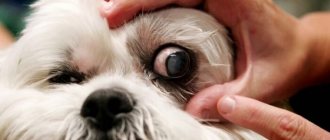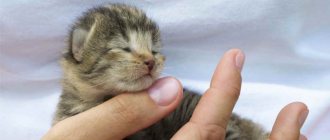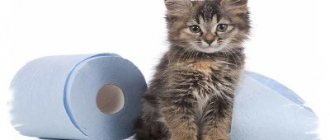For what reasons does the disease appear?
The detection of a white film on the eyes of cats or the third eyelid, the formation of purulent discharge, swelling: indicates that the fluffy cat has obvious problems with the visual apparatus. Such violations can be detected for all sorts of reasons:
- for various conjunctivitis;
- due to mechanical impact;
- with entropion of the eyelids (entropion) – Maine Coons, British, Persians and Scottish Folds are at risk;
- if you are allergic to various irritants;
- with corneal necrosis;
- as a result of chemical exposure to the mucous membrane of the visual organ;
- if the fluffy has microparasites (internal or external);
- if there are problems in the functioning of the gastrointestinal tract and other organs;
- if the mustache is bothered by internal diseases (bacterial, viral or fungal);
- due to the formation of tumors (adenomas).
You should know that the cat's third eyelid is a necessary part of the visual apparatus in whiskers, which performs a protective function: to prevent infection from entering the mucous membrane of the eye and as a kind of barrier that softens the effects of mechanical damage.
This whitish or bluish eye membrane is practically invisible when looking at the barbel. You can notice it when the purr bends its head towards the floor or begins to blink, then a thin film completely covers the entire eye.
This action helps the mustache get rid of excess dust particles, and also promotes the distribution of tear fluid inside the eyelid.
If the third eyelid falls out or a film becomes visible on one or both eyes in cats, then it is necessary to determine the root of the problem and begin treatment immediately.
Short description
Unfortunately, a disease in which part of a cat's eyelid is covered with a white, opaque film is common. The film bears the name of the third century and is of great importance. It removes foreign particles and dust, and also distributes tear fluid. The third eyelid (conjunctival fold or nictitating membrane) is located at the inner corner of the eye. It is almost impossible to notice it in a healthy animal. If the cat is sick, the membrane becomes inflamed and turns white.
Diagnosis of why a cat's eye is half closed
If the above signs occur, you should immediately sound the alarm and do not delay a visit to the veterinarian.
The disease can pose a real threat to the health of your pet, making it blind.
I will talk about different types of third eyelid prolapse:
- Protrusion. When the film covers more than half of a cat's eyelid, the color of the film is white or grayish. Most often, protrusion is just a symptom of deeper diseases of the nervous system.
- Prolapse of the nictitating membrane. It is diagnosed if the film covers no more than half of the organ. It is a pink spherical formation in the inner corner. It occurs quite rarely only in cat breeds with a flattened muzzle. May be accompanied by purulent conjunctivitis. If pus is present, emergency surgery is required.
- Eversion. A rare pathology is a crease in the cartilage of the third eyelid. Very similar to prolapse, but with curvature of the cartilage in the inner corner of the eye.
- Third century injury. Occurs when damaged by claws during fights or mating games of cats. The damage is accompanied by blood and purulent conjunctivitis. If the gap is small, you don’t have to worry, because the wound will heal on its own if the pet is in good health. I advise you to contact a veterinarian if the affected third eyelid can separate and hang on your pet’s eye. No need to hesitate! After all, the sooner you and your veterinarian solve the problem, the greater the chance of restoring the full functioning and mobility of the third eyelid.
- Horner's syndrome. This is a serious neurological disorder with a white film on the eye, drooping of the eyelid and constriction of the pupil. Cats with this syndrome are diagnosed with dysfunction of the brain, neck, and nerve plexuses. If you find such symptoms in your pet, consult a neurologist.
A cat's dehydration, exhaustion, prolonged vomiting, diarrhea and general depression can cause third eyelid prolapse in both eyes.
If, apart from the white film, you do not observe other symptoms, this may be Haw's syndrome.
Third eyelid injury
In this case, there is no need to see a doctor - your pet’s eyes will eventually regain their previous appearance.
The examination of the animal is carried out in a certain order, which allows you not to miss details or nuances when differentiating the diagnosis:
- assessment of vision of the damaged organ (preserved or not);
- assessment of general appearance and comparison of symmetrical features (size and shape of pupils, size of the palpebral fissure, size and changes in the eyelids, size of the eyeballs);
- assessment of the condition of the eyeball (size, shape, presence of injuries, location in the pupil).
We suggest you read: Amyloidosis in cats: signs, diagnosis and treatment
If, apart from the white film, you do not observe other symptoms, this may be Haw's syndrome.
The cause of the underlying pathology is determined. Pay attention to the symmetry of the eye lesion. If clinical symptoms are observed on one side, then the cause of the disease is a congenital anatomical anomaly that requires surgical correction. Or is it the irritating effect of a foreign object caught under the film.
It is necessary to monitor the dynamics of the disease. A conscientious fellinologist records everything that happens to the cat in writing. Your veterinarian may need this information when taking your medical history. For example, with chlamydia, sometimes one eye is damaged, then the other.
Symmetrical damage to the visual organs indicates the presence of an underlying disease - infectious, invasive or non-contagious etiology. In such situations, the doctor prescribes additional tests. To identify the pathogen, samples of eye washes are taken.
Blepharitis Domestic cats always bring joy and happiness to their owner. But this is only provided that the animal does not have health problems. The situation when a pet gets sick is not the most pleasant. The question immediately arises - what needs to be done? In this article we will look at the problem when a cat’s eyes are half covered with film. You will find out why it appears and what treatment will be effective.
Causes of the disease
A disease in which a cat's eyes are half covered with a film is not so rare. The filmy layer on the surface of a cat's eyelids (on the inside) in most cases is white. Sometimes it covers a significant part of the animal's eye. It doesn’t look pretty, and the pet’s well-being worsens.
- proper distribution of tear fluid;
- removal of foreign elements from the surface of the visual organ (for example, dust, grains of sand);
- producing up to 1/3 of tear fluid.
- conjunctivitis;
- infections caused by bacteria;
- diseases of internal organs (most often associated with disruption of the digestive tract);
- parasites in the animal's body;
- mechanical eye damage;
- foreign objects getting into the cat’s eyes, causing injury, inflammation and swelling;
- cataracts, blockage of the eye vessels, strabismus (the presence of such problems is indicated by the blue color of the film on the eyes).
Diagnostics
If you see that your cat's eyes are covered with a film, we advise you to contact a veterinarian as soon as possible. Timely treatment will help quickly restore vision and avoid re-infection.
A specialist doctor uses an ophthalmoscope to determine the cause of the underlying pathology of the eye disease and propose an effective course of treatment. In some cases, surgery may be required.
It is imperative to monitor the dynamics of the disease.
External manifestations of the disease
The presence of a third eyelid in a mustache is signaled not only by a change in the cat’s appearance, but also by changes in its behavior:
At the same time, you can see profuse lacrimation in your pet, possibly the presence of pus and a change in the shade of the mucous membrane to red. If you do not help the tailed creature, there is a high probability of vision loss.
Loss of the third eyelid in a pet is not always a dangerous sign; in old cats this phenomenon is common, which is explained by age-related changes (weight loss, sunken eyes). In any case, the best solution would be to consult a specialist.
Treatment
Therapy is prescribed depending on the diagnosis. Surgical and conservative treatment methods are used.
A small tumor is removed surgically without affecting the membrane itself. A large tumor is excised along with the film, and the animal is at risk of blindness.
Injuries are treated conservatively if they are shallow. Such wounds in cats heal quickly.
The injured nictitating membrane is sutured, then antibiotics are prescribed.
For inflammation due to bacterial infection, broad-spectrum antibiotics are prescribed in the form of drops and ointments.
For fungal diseases, fungicidal ointments are used.
Vitamins, minerals, nutrients, and immunomodulators are prescribed as additional treatment.
White film on both eyes is a dangerous sign
If you find a whitish film on one eyelid of a furry cat, then most likely this change occurred due to the entry of a speck or other foreign body. A more dangerous situation is when a film is detected on both eyes of the cat, which is most likely caused by an infectious disease.
Very often, males damage their eyes with their claws during a fight. Wounds that appear on the eyelids can easily become infected.
If there is an infection, a film may form in the eyes of the mustache. Some diseases (keratitis, corneal ulcer, etc.) signal themselves by the appearance of green or white discharge. If such signs are noticed in your pet, then urgently take him to the veterinary clinic.
Reasons for appearance
All cats have a third eyelid, which usually remains invisible while the pet is awake. Therefore, its appearance in everyday life causes concern and often requires a visit to the veterinary clinic. When this membrane becomes visible, this indicates that it is not sufficiently or excessively moistened, the eyes are not completely cleared of dust that enters them, and the functionality of the film is impaired.
© shutterstock
There are two degrees of third eyelid prolapse:
- Protrusion;
- Prolapse.
About first aid measures
So what to do with the cat? Let us immediately note that you should not do anything on your own without first consulting with a veterinarian. This way you can only seriously harm your pet’s health, and in some cases leave him without an eye altogether.
But in mild cases of conjunctivitis, the owner can help the cat. To do this, you can use a weak solution of hydrogen peroxide. A cotton swab is moistened with it and the crusts and liquid exudate that accumulate in the corners of the eye are carefully washed off. At the same time, tetracycline ointment is placed under the eyelid (pictured). It effectively relieves inflammation and reliably prevents the further development of pathogenic microflora.
To wash the eye itself, it is better to use a weak solution of either furatsilin or potassium permanganate. In the latter case, the color of the medicinal composition should be pale pink, since in higher concentrations potassium permanganate can be dangerous for the cornea. In addition, good results are obtained by washing the eyes with decoctions of sage and chamomile. They have a bactericidal effect and also relieve swelling and the main signs of the inflammatory process.
Swollen eyelids in a cat are always an alarming symptom. It cannot be left unattended - the animal must be shown to a veterinarian-ophthalmologist as soon as possible.
Recommendations for owners
After treatment, the veterinarian will provide recommendations to cat owners on care and nutrition, which owners must strictly follow, constantly monitoring the condition of the eyes and health until the animal is completely healed.
For eye rinsing and hygiene, medicinal decoctions of medicinal herbs and ophthalmic solutions (boric acid, warm water, decoction of chamomile, sage) are prescribed. Potassium permanganate lotions, tricylan powder, and furatsilin solution (the tablet is diluted in water) also help well.
Advice! After therapeutic therapy, even if the cat’s white film has disappeared from his eyes, his condition has improved, do not be lazy to take your pet to the clinic for a second scheduled examination!
How to help your pet?
When an illness is identified, it is better to immediately identify its cause by seeking the help of an experienced veterinarian.
First, the veterinarian will examine the affected area using an ophthalmoscope and take smears from tear secretions, which will help exclude or confirm the presence of an infectious disease.
If the root of the problem is a disease, the specialist will prescribe anesthetic drops for sore eyes and special ointments. Of course, it is very important to stop the disease itself.
At the same time, the cat's eyes will need to be washed at home to rid them of dirt. If you notice that a kitten or an adult suffers from lacrimation, suppuration and constantly rubs its eyes, then use the following ingredients as a wash:
- boric acid;
- olive oil;
- warm clean water.
Secure the pet well; it is better to carry out the procedure in pairs, wrapping the mustache in a towel. Then gently rinse her eyes using a generously moistened cotton pad or pipette. Afterwards, wipe your pet’s eyes with a clean swab from the outer corner of the eye to the inner.
For suppuration and tearfulness, Lacrimin drops are effective. If creatitis is detected in a tailed creature, then you cannot do without medical help - follow all the doctor’s instructions, this will preserve your pet’s vision.
For cataracts (when, in addition to the formation of a film, the lens becomes cloudy), blockage of the ocular ducts and strabismus, surgical intervention will most likely be required.
It is undesirable for the cat to rub its eyes during therapy, so it is better to use a special veterinary collar.
Treatment of third eyelid prolapse at home
A cat's eyes are a very vulnerable place. Many manipulations that the owner is able to carry out at home on his own may not only not improve the situation, but also cause additional harm. This is why you should not self-medicate without the supervision of a doctor.
What you should not do on your own if you have a prolapsed third eyelid:
- try to set the gland on your own;
- try to remove foreign objects stuck in it from the eye;
- use strong medications without a doctor’s prescription;
- You should not ignore the problem, as the animal’s condition can deteriorate very sharply.
In case of minor problems, it is not necessary to immediately take your cat to the hospital, but it is worth consulting with a veterinarian by phone in any case. If the inflammation is minor, the doctor may prescribe special eye drops for the first time. The owner can handle their introduction independently at home.
You may also need to rinse your pet's eyes. But you should not use strong tea or other folk remedies for this. This procedure requires special solutions that are sold in pharmacies.
Causes and symptoms of eye diseases in cats
The most common diseases in cats are:
Inflammation of the eyelids
. With phlegmous inflammation, the eyelid swells and purulent mucus flows from the eye. With normal inflammation, the cat begins to scratch its eyes. The eyelids become red and thickened. The disease appears due to vitamin deficiency, eczema. Phlegmous inflammation develops after strong calculations and deep wounds.
Bruises and wounds
. A cat can receive these injuries from a fall or after a fight. The wound can be superficial, deep or through. The main symptom is severe swelling, redness and even bleeding from the eyes.
Turn of the century
. The skin turns inward. This causes a strong inflammatory process. Volvulus can be caused by a foreign body getting into the cat's eye or exposure to chemicals. Without timely assistance, the cat may develop conjunctivitis or keratitis. In advanced cases, an ulcer will appear on the cornea.
Symptoms of the disease include lacrimation and photophobia. The eyelid begins to swell, changing its appearance.
You can recognize the listed eye diseases in cats from photos.
Types of conjunctivitis
Conjunctivitis is considered the most common disease among cats. It has the following varieties:
- Purulent.
- Allergic.
- Acute catarrhal.
- Follicular.
With purulent conjunctivitis, the general condition of the cat worsens. The animal's body temperature rises, and copious pus begins to discharge from the eyes. Diarrhea and vomiting may occur.
Allergic conjunctivitis
in a cat it causes contact with an allergen. At first, the discharge from the eyes appears clear. If left untreated, they become purulent.
Acute catarrhal conjunctivitis is always accompanied by redness of the eyes and severe swelling. Cats experience pain, tears flow, and serous-mucous discharge occurs. The main reason is injury and lack of vitamin A in the body.
Follicular conjunctivitis is characterized by inflammation of the lymphatic follicles. They are on the inside. The disease is chronic and requires long-term treatment. Surgery is possible.
The photo clearly shows all types of conjunctivitis.
Types of keratitis
Keratitis is a disease of the cornea of the eyes. The most common types are:
- Superficial purulent.
- Vascular superficial.
- Purulent deep.
With superficial keratitis, the upper (epithelial) layer of the cornea becomes inflamed. The cat is in pain and afraid of light. The cornea takes on a gray color and swelling develops. This type of illness usually occurs due to injury.
With vascular keratitis, capillaries grow into the upper layer of the cornea, causing clouding of the eyes.
Purulent deep keratitis is a very serious disease caused by microbes that have penetrated the stroma of the cat’s cornea. The cat begins to be afraid of light and scratches its eyes continuously. The cornea takes on a yellowish tint. Capillaries begin to grow into the cornea. The cause of the disease is considered to be injury and infection. The cat will be sick for a long time.
Corneal ulcer
To this disease. Causes infections that develop after deep wounds. This may also be a complication after suffering purulent keratitis. There are 2 types of ulcers: perforated and purulent. The main symptom is severe pain. Therefore, the animal is always restless.
When a perforated ulcer appears, purulent discharge from the eyes is noticeable. The cornea takes on a gray tint. Spasms of the eyelids and fear of bright light are often observed. After treatment of ulcers, scarring will be visible.
Glaucoma
Glaucoma in cats can be acute or congenital. The main symptom is increased eye pressure. The cornea becomes cloudy, loses sensitivity and becomes colorless.
The eyeballs harden and increase in size. The cause of the disease may be hemorrhage, dislocation and swelling of the lens, a complication after suffering purulent keratitis.
Cataract
Cataract is clouding of the lens. It can be congenital, toxic, traumatic, symptomatic.
At the last stage, the pet has difficulty seeing in the affected eye. The lens becomes white. The disease develops as a result of infection, injury or inflammation. Older cats often suffer from cataracts.
A thorn in ophthalmic diseases
A white spot on the eye can appear in cats with other pathologies. All of them are characterized by a severe course and threaten the pet with disability:
- glaucoma is the most severe disease in domestic cats in terms of course and complexity of treatment;
erosion of the cornea of the eye develops due to mechanical injuries, burns, viral and bacterial diseases;- infectious processes caused by bacteria, viruses, fungi cause clouding of the cornea.
There are a number of diseases that affect the eyeball, which leads to the development of leukoma.
Preventive measures
To protect the tailed creature and minimize the occurrence of problems with the visual apparatus, you should do the following:
- plan a cat’s diet - it must be balanced and consist of quality products;
- do not forget about additional vitamins in the cat’s menu;
- periodically rinse your cat's eyes with Furacilin (1 tablet per 100 g of water);
- use potassium permanganate for preventive purposes;
- regularly examine the eyes of the mustachioed creature and monitor changes in its behavior;
- do not forget to free your pet from roommates - worms, fleas, etc.
- Take your pet to the veterinary clinic for examinations at least once a year.
If you notice slight redness of the mucous membrane and tearing, use Tricilin powder on the affected areas.
Symptoms of the disorder
The disease can develop over a certain period. At first, the nictitating membrane may simply become inflamed and red. It will constantly close part of the eye, interfering with the animal's view. Sometimes the loss of the third eyelid occurs suddenly. The owner can see an inflamed sac in the edge of the animal's eye. This condition is quite dangerous, as the eye becomes vulnerable to various infections. In addition, due to disruption of the tear ducts, the cornea may dry out.
When the third eyelid prolapses, the following symptoms are also possible:
- The animal constantly rubs its eye with its paws. This is quite dangerous, as the cat can further damage the nictitating membrane or introduce an infection into it.
- Tears or pus ooze from the eye.
- The cat's vision is impaired.
Often, prolapse of the third eyelid occurs against the background of other health problems, and therefore the following symptoms may be observed:
- Significant increase in body temperature.
- Decline in activity, apathy.
- Anxiety.
- Inflammation of the mucous membranes is possible.
- Bleeding from the eye.
Prevention
If the film has already appeared, I advise you to adhere to the following rules when caring for your pet at home:
- Good balanced diet;
- If you discovered the film on the first day, I advise you to use Lacrimin or Tricilin powder;
- Add vitamins to food;
- Dissolve a furatsilin tablet in 100 grams of water and rinse the sore eye;
- Make lotions with a solution of manganese;
- Instill antibiotics, for example cyprobid or colbiocin;
- Apply Zovirax ointment to the film.
To protect your pet, you need to constantly carry out various preventive measures. After all of the above, I want to summarize - periodic prevention, timely diagnosis and treatment of the disease will help your pet stay healthy and preserve his vision. Be careful about those you have tamed!
The cat's eyes are watering
The secretion of tears in cats, like in any other animal, is the body’s reaction to external stimuli.
The common occurrence of a small amount of dried fluid appearing in the corners of a cat's eyes after sleep can simply be ignored, but there are a few common eye problems that veterinarians identify in cats
One of the most common diseases is conjunctivitis, it affects many cats, including often domestic ones, it mainly manifests itself as an infection of the inside of the eyelid and the surface of the eye itself. There can be many causes for conjunctivitis in cats, and owners are urged to consult a veterinarian as soon as symptoms appear.


